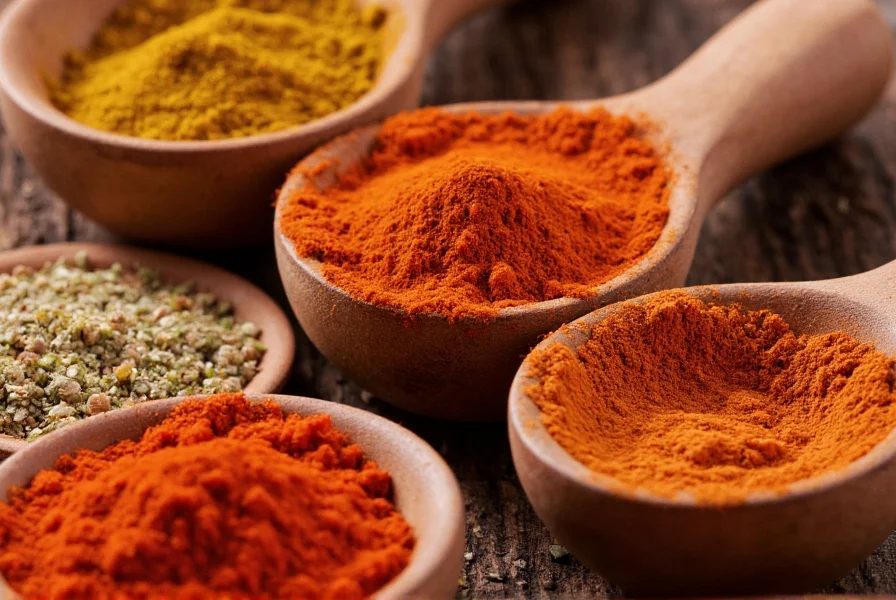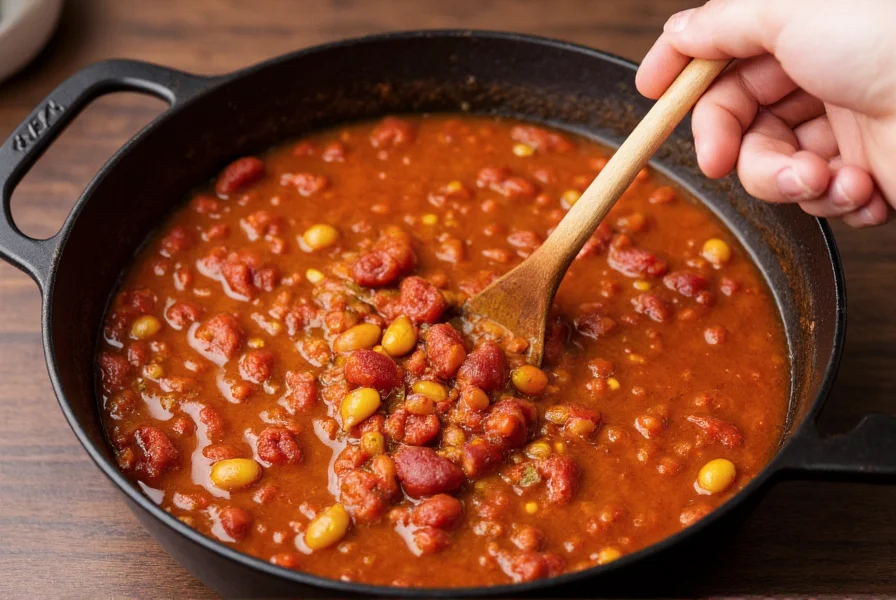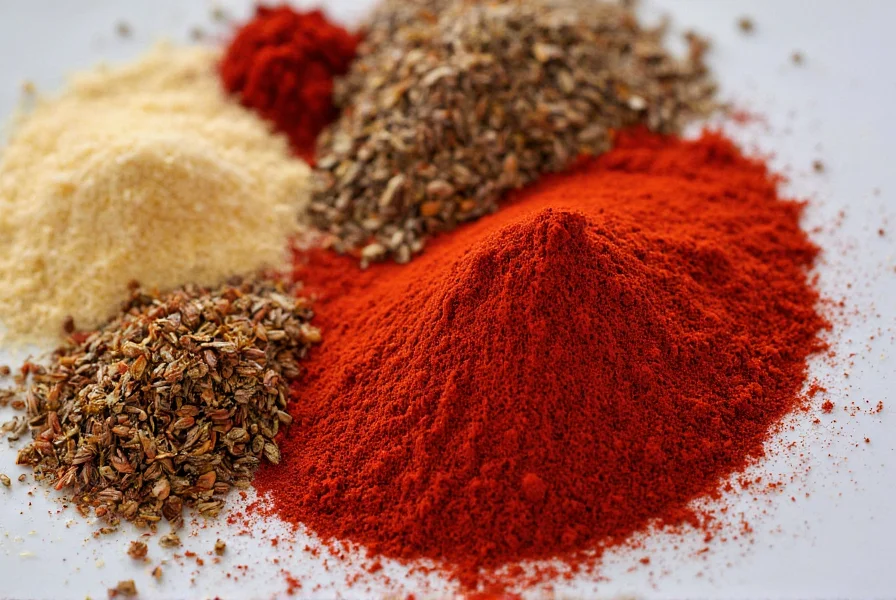Creating exceptional chili isn't just about meat and beans—it's about building layers of flavor through thoughtful spice selection. While recipes vary across regions and personal preferences, certain spices consistently elevate chili from ordinary to extraordinary. Understanding which spices work best and how they interact can transform your cooking approach and help you develop your signature chili recipe.
Core Spices That Define Chili Flavor
Every great chili starts with a solid foundation of essential spices. These ingredients form the backbone of traditional chili flavor profiles and should be present in nearly every recipe:
| Spice | Flavor Profile | Recommended Amount (per lb of meat) | When to Add |
|---|---|---|---|
| Chili Powder | Earthy, slightly sweet, moderate heat | 2-3 tablespoons | Beginning of cooking |
| Cumin | Warm, earthy, slightly smoky | 1-2 teaspoons | Beginning of cooking |
| Paprika | Sweet or smoky depth | 1-2 tablespoons | Beginning of cooking |
| Mexican Oregano | Citrusy, earthy, more robust than Mediterranean oregano | 1 teaspoon | Last 30 minutes of cooking |
Chili powder isn't a single spice but a blend typically containing ground chilies, cumin, garlic powder, and oregano. For authentic flavor, choose a quality commercial blend or create your own by combining ancho, pasilla, and guajillo chilies. Cumin provides that distinctive earthy warmth that defines traditional chili, while paprika—particularly smoked paprika—adds complexity without overwhelming heat.

Secondary Spices for Depth and Complexity
Once you've mastered the core spices, consider these secondary ingredients to add nuance and personal flair to your chili:
- Cayenne pepper: For adjustable heat—start with 1/8 teaspoon per pound of meat and increase to taste
- Coriander: Adds citrusy notes that balance richness (1/2 teaspoon per pound)
- Mustard powder: Enhances other flavors without tasting like mustard (1/4 teaspoon)
- Cocoa powder: Deepens color and adds subtle bitterness that balances heat (1 tablespoon)
- Star anise: One pod adds complexity without licorice flavor (remove before serving)
These supporting spices work best when added thoughtfully rather than all at once. For example, adding a small amount of cocoa powder creates depth without making your chili taste like chocolate. Similarly, a single star anise pod infuses subtle complexity that disappears once removed, leaving only enhanced flavor.
Regional Variations in Chili Spice Profiles
Chili traditions vary significantly across regions, each with distinctive spice approaches:
- Texas-style: Focuses on meat and chili peppers with minimal spices—primarily cumin, garlic, and varying heat levels from different dried chilies
- New Mexico: Features locally grown red chilies with oregano and minimal cumin
- Cincinnati-style: Includes warming spices like cinnamon and allspice for its distinctive sweet-heat profile
- Midwestern: Often incorporates kidney beans with balanced spice levels appealing to broader palates
Understanding these regional differences helps you identify which spice profile aligns with your preferences. If you enjoy smoky depth, emphasize smoked paprika and chipotle powder. For traditional Texas-style, focus on high-quality dried chilies and cumin while minimizing other spices.
Timing Matters: When to Add Spices
The timing of spice addition significantly impacts flavor development in chili. Many home cooks make the mistake of adding all spices at once, but strategic timing creates superior results:
- Dry spices (chili powder, cumin, paprika): Add early in the cooking process after browning meat. The heat toasts the spices, releasing essential oils and creating deeper flavor
- Fragile herbs (Mexican oregano, cilantro): Add during the last 30 minutes to preserve their delicate flavor compounds
- Acidic elements (tomato paste, vinegar): Add midway through cooking to balance richness without overwhelming other flavors
For optimal flavor integration, try "blooming" your spices by cooking them in a small amount of oil for 30-60 seconds before adding liquids. This technique extracts maximum flavor from dried spices and creates a more cohesive flavor profile throughout your chili.
Avoiding Common Spice Mistakes
Even experienced cooks make these frequent errors when seasoning chili:
- Over-relying on pre-made chili seasoning: These often contain excessive salt and fillers. Create your own blend for better control
- Adding all spices at the end: Dry spices need time to meld with other ingredients—add early for best results
- Not tasting as you go: Spice requirements vary based on meat type, tomatoes, and other ingredients
- Using stale spices: Ground spices lose potency after 6 months—freshness matters for vibrant flavor
When adjusting spice levels, remember that heat intensifies over time. It's better to start with less cayenne or hot peppers and add more later than to overheat your chili initially. If you accidentally make your chili too spicy, add dairy (like sour cream when serving), a touch of sugar, or acidic elements like lime juice to balance the heat.
Customizing Spices for Dietary Preferences
Whether accommodating specific dietary needs or simply exploring new flavor dimensions, these spice adjustments maintain chili's essence while adapting to different requirements:
- Vegetarian/vegan: Boost umami with smoked paprika, cumin, and a touch of soy sauce or liquid aminos
- Low-sodium: Increase use of fresh garlic, onion, and acid (vinegar or lime) to compensate for reduced salt
- Mild heat preference: Use sweet paprika and ancho chili powder instead of hotter varieties
- Gluten-free: Ensure chili powder blends don't contain flour or anti-caking agents (make your own to be certain)
For those exploring traditional chili without meat, consider adding mushrooms or roasted eggplant to provide the textural richness that complements the spice profile. The key is maintaining the balance between earthy, warm, and slightly sweet elements that define great chili regardless of the protein source.
Developing Your Signature Chili Blend
The journey to perfect chili involves experimentation and refinement. Start with the core spices in recommended proportions, then adjust based on your preferences. Keep notes on what works—spice preferences are highly personal, and your ideal blend might differ from traditional recipes.
Remember that chili often tastes better the next day as flavors continue to meld. When making large batches, consider under-spicing slightly, knowing the flavors will intensify during storage. With practice, you'll develop an intuitive sense for balancing the earthy warmth of cumin, the depth of paprika, and the variable heat that makes chili uniquely satisfying.












 浙公网安备
33010002000092号
浙公网安备
33010002000092号 浙B2-20120091-4
浙B2-20120091-4